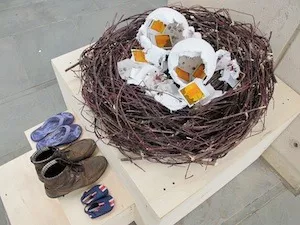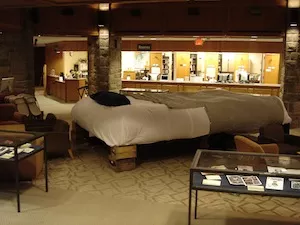Swarthmore Alum Returns to Teach His Craft
Since its debut on Parrish Beach in 2002, the Big Chair has become synonymous with Swarthmore College. The oversized Adirondack chair possesses an iconic allure, as students and visitors to the campus relish in climbing, sitting on and taking pictures of it.
Yet many are unaware of its artistic beginnings as a 2002 public art project of Jake Beckman '05. During his time at Swarthmore, Beckman created other notable works, including the guerilla installation of large Converse All-Stars shoes that hung off Parrish or the steel clock in the Science Center Commons. But in his current role as a visiting professor at Swarthmore, it's his students' public art projects that have been taking center stage.

Ruben An '13 created a piece that reflected upon memory, family, childhood and loss (above) for his final Art in Public project.
During his undergraduate time in the studio arts program, Beckman honed his interest in public art. Finding it possessed a "certain thrill," he liked public art's inherent temporary nature and its ability to spark a dialogue.
"Whether people liked it or didn't like it, it was still out there for conversation, but it wasn't this thing that stuck around forever," Beckman said. After Swarthmore, Beckman continued producing and exhibiting his work in his hometown of Cleveland, eventually graduating with a MFA in 2011 from the Rhode Island School of Design.
Returning to Swarthmore last year as a visiting professor in the Art department, Beckman taught the "Art in Public" course in the spring of 2011. Examining public art through major categories such as monument, words and images, and performance, the course aimed not only in educating the students about public art, but also allowed students to construct their own projects. All students worked toward producing a final project that would be displayed around campus, such as one by Ruben An '13 that reflected upon memory, family, childhood and loss, or the inflating and flickering light post by Max Rennebohm '13.
Beckman's modeling of the course involved discussion, readings, and critique. "We did a lot of discussing of contemporary issues of art in public space, and lot of discussion about ethics and discussions about effectiveness of pieces, [and about] the tools that you use as an artist to communicate your ideas," Beckman said.
Se Eun Gong '13, a student in the course, noted that there were weekly assignments, such as model making, and that Beckman set aside "a big chunk of time for critique." Working collectively was also one of the main characteristics of the course, as students kept a communal journal of "what if" ideas, writing down creative and imaginative scenarios that might spark an idea for individual projects. Many of the students' final projects actually emerged from ideas written down in the sketchbook.
While most of the projects were displayed in May 2012, one final project appeared in McCabe Library this past fall. Gong's final project, which was an oversized air mattress with large sheets and pillows, was inspired by how one might react to seeing bugs in his or her personal space.

Displayed in McCabe Library this past fall, Se Eun Gong '13's public art project was meant to alter perceptions of space by putting a private object, a bed, in a public space.
"When you see [a bug], it just turns your room into some place you cohabitate with some other living creatures."
Gong, an English literature and political science major from Seoul, proceeded to write in the 'what if' sketchbook the question: "What if you are constantly aware of the existence of other living creature[s] in your room?" This led her to explore the relation between a private space within a public and frequently used space.
"The bed is considered private, safe, warm, clean," Gong said. "I thought putting a bed in that space could possibly change people's perceptions of the space. I just wanted to see how people would respond to going into a place that's now looking like a very private, exclusive space."
Constructing the large air mattress involved acquiring plastic, large swathes of fabric and the fan to inflate it. "I had to make each separate part, and assemble all of them together at the very end, so I couldn't really see the complete product [until] the very end," she said. Gong noted that access to material was "pretty much endless," which allowed students to feel more open to certain ideas they had for projects. Beckman said that he "really wanted the concepts to drive the work, rather than the materials." Instead of being limited in their creativity by limited supplies, he hoped that they would "play around with and explore different materials and how they can be utilized to get their concepts across." While materials are one aspect of the artworks, public art is also intrinsically tied to the space it inhabits.
Aiming to experiment with a familiar space on campus, Gong first tried to have the bed placed in Kohlberg Courtyard, whose trellises reminded Gong of bedposts. When Kohlberg Courtyard became a difficult space to place the bed because of the rainy last weeks of May, Gong had to postpone its unveiling, and rethink where she wanted to display her work. "I was talking to my classmates, and one of them suggested McCabe," Gong said. "It's public, but [the reading area in the main lobby] is very enclosed, so I chose this space."
The mattress went up for only a weekend in McCabe, but it made quite the impression, as it completely changed the familiar studying spot. Some students interacted with the piece, as Gong noted that one student tried to jump on the mattress before she dismantled it. Despite its brief installment, she noted that the piece involved "a lot of work" in the process of creating it - an acknowledgement that Beckman hoped that his students gained.
"I really wanted them to get some basic skills, so that they felt empowered to use a drill, [and do] really simple stuff ... even just an appreciation for how long it takes to make something, and make something well," he said. The amount of creativity and openness to ideas added to the success of the course. "None of the students were at a loss for coming up with ideas, so it was really sort of a beautiful thing to give some parameters and then have this sort of wealth of ideas coming in," Beckman said.
Though the "Art in Public" course is not offered this spring, Beckman will continue working at Swarthmore, teaching the Container as Architecture - a sculpture-based course that focuses on clay as a medium. Gong hopes to take this course, as she wants "to be continually involved in art on campus."



